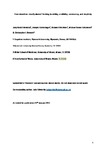Classifying Alarms: Seeking Durability, Credibility, Consistency, and Simplicity
| dc.contributor.author | Edworthy, Judy | |
| dc.contributor.author | Schlesinger, JJ | |
| dc.contributor.author | McNeer, RR | |
| dc.contributor.author | Kristensen, MS | |
| dc.contributor.author | Bennett, CL | |
| dc.date.accessioned | 2017-06-27T08:48:04Z | |
| dc.date.available | 2017-06-27T08:48:04Z | |
| dc.date.issued | 2017-02 | |
| dc.identifier.issn | 0899-8205 | |
| dc.identifier.issn | 1943-5967 | |
| dc.identifier.uri | http://hdl.handle.net/10026.1/9552 | |
| dc.description.abstract |
Alongside the development and testing of new audible alarms intended to support International Electrotechnical Commission 60601-1-8, a global standard concerned with alarm safety, the categories of risk that the standard denotes require further thought and possible updating. In this article, we revisit the origins of the categories covered by the standard. These categories were based on the ways that tissue damage can be caused. We consider these categories from the varied professional perspectives of the authors: human factors, semiotics, clinical practice, and the patient or family (layperson). We conclude that while the categories possess many clinically applicable and defensible features from our range of perspectives, the advances in alarm design now available may allow a more flexible approach. We present a three-tier system with superordinate, basic, and subordinate levels that fit both within the thinking embodied in the current standard and possible new developments. | |
| dc.format.extent | 50-57 | |
| dc.format.medium | ||
| dc.language | en | |
| dc.language.iso | en | |
| dc.publisher | Association for the Advancement of Medical Instrumentation (AAMI) | |
| dc.subject | Clinical Alarms | |
| dc.subject | Equipment Failure Analysis | |
| dc.subject | Guidelines as Topic | |
| dc.subject | Technology Assessment, Biomedical | |
| dc.subject | Terminology as Topic | |
| dc.subject | United States | |
| dc.subject | Vocabulary, Controlled | |
| dc.title | Classifying Alarms: Seeking Durability, Credibility, Consistency, and Simplicity | |
| dc.type | journal-article | |
| dc.type | Journal Article | |
| plymouth.author-url | https://www.ncbi.nlm.nih.gov/pubmed/28296464 | |
| plymouth.issue | s2 | |
| plymouth.volume | 51 | |
| plymouth.publication-status | Published | |
| plymouth.journal | Biomedical Instrumentation & Technology | |
| dc.identifier.doi | 10.2345/0899-8205-51.s2.50 | |
| plymouth.organisational-group | /Plymouth | |
| plymouth.organisational-group | /Plymouth/Faculty of Health | |
| plymouth.organisational-group | /Plymouth/Research Groups | |
| plymouth.organisational-group | /Plymouth/Research Groups/Centre for Brain, Cognition and Behaviour (CBCB) | |
| plymouth.organisational-group | /Plymouth/Research Groups/Centre for Brain, Cognition and Behaviour (CBCB)/Behaviour | |
| plymouth.organisational-group | /Plymouth/Users by role | |
| dc.publisher.place | United States | |
| dcterms.dateAccepted | 2017-01-27 | |
| dc.identifier.eissn | 1943-5967 | |
| dc.rights.embargoperiod | Not known | |
| rioxxterms.versionofrecord | 10.2345/0899-8205-51.s2.50 | |
| rioxxterms.licenseref.uri | http://www.rioxx.net/licenses/all-rights-reserved | |
| rioxxterms.licenseref.startdate | 2017-02 | |
| rioxxterms.type | Journal Article/Review |


